Paintings by Adolf Hitler
Adolf Hitler, leader of the Nazi Party in Germany in the years leading up to and during World War II, was also a painter.[1] He produced hundreds of works and sold his paintings and postcards to try to earn a living during his Vienna years (1908–1913). Despite little success professionally, he continued to paint throughout the whole of his life.
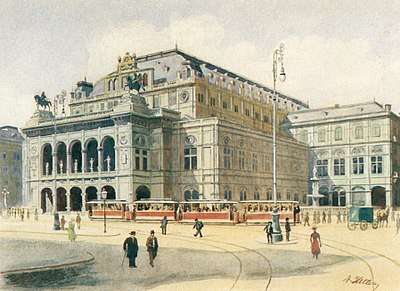
A number of his paintings were recovered after the second World War and have been sold at auction for tens of thousands of dollars. Others were seized by the United States Army and are still held by that government.
Hitler's style and influences
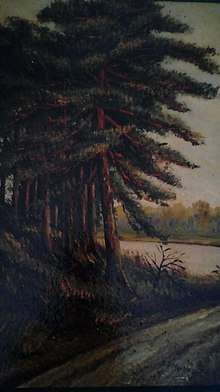
Hitler's style was very calculated when representing architecture in his paintings. Instead of progressing in his artistic influence, his works copied the artists of the nineteenth century and other masters preceding him.[2] He claimed to be the synthesis of many artistic movements but drew primarily from Greco Roman classicism, the Italian Renaissance, and Neoclassicism. He liked the technical ability of these artists, as well as the understandable symbolism.[3] He called Rudolf von Alt his greatest teacher. The two show similar subject matter and use of color, but Alt displays fantastical landscapes giving equal if not more attention to nature and the surrounding environment than to the architecture.
History
Artistic ambition
In his 1925 autobiography Mein Kampf, Adolf Hitler described how, in his youth, he wanted to become a professional artist, but his dreams were ruined because he failed the entrance exam of the Academy of Fine Arts Vienna.[4] Hitler was rejected twice by the institute, once in 1907 and again in 1908. In his first examination, he had passed the preliminary portion which was to draw two of the assigned iconic or Biblical scenes, in two sessions of three hours each. The second portion was to provide a previously prepared portfolio for the examiners. It was noted that Hitler's works contained too few heads.[5] The institute considered that he had more talent in architecture than in painting.[6] One of the instructors, sympathetic to his situation and believing he had some talent, suggested that he apply to the academy's School of Architecture. However, that would have required returning to secondary school from which he had dropped out and which he was unwilling to do.
According to a conversation in August 1939 before the outbreak of World War II, published in the British War Blue Book, Hitler told British ambassador Nevile Henderson, "I am an artist and not a politician. Once the Polish question is settled, I want to end my life as an artist."[6][4]
Vienna period
From 1908 to 1913, Hitler tinted postcards and painted houses for a living. He painted his first self-portrait in 1910 at the age of 21. This painting, along with twelve other paintings by Hitler, was discovered by US Army Sergeant Major Willie J. Mc Kenna in 1945 in Essen, Germany.
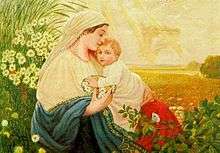
Samuel Morgenstern, an Austrian businessman and a business partner of the young Hitler in his Vienna period, bought many of the young Hitler's paintings. According to Morgenstern, Hitler came to him for the first time at the beginning of the 1910s, either in 1911 or in 1912. When Hitler came to Morgenstern's glazier store for the first time, he offered Morgenstern three of his paintings. Morgenstern kept a database of his clientele, through which it was possible to locate the buyers of young Hitler's paintings. It was found that the majority of the buyers were Jewish. An important client of Morgenstern, a lawyer by the name of Josef Feingold, bought a series of paintings by Hitler depicting old Vienna.[8]
World War I
When Hitler served in World War I at the age of 25 in 1914, he carried fine paper and canvas with him to the front and spent hours of leave time drawing and painting. The works he painted during this period were among his last before he became a politician. The themes of his wartime painting included farmers' houses, the dressing-station, etc.
Auction sales
A number of Hitler's paintings were seized by the United States Army at the end of World War II. They were taken to the United States with other captured materials and are still held by the US. government, which has declined to allow them to be exhibited.[9] Other paintings were kept by private individuals. In the 2000s, a number of these works began to be sold at auction.[10] In 2009, auction house Mullock's of Shropshire sold 15 of Hitler's paintings for a total of £97,672 (US $143,358).[11] while Ludlow's of Shropshire sold 13 works for over €100,000.[12] In a 2012 auction in Slovakia, a mixed-media painting fetched €32,000.[13] And on November 18, 2014, a watercolor by Hitler of the old registry office in Munich sold for €130,000 at an auction in Nuremberg. The watercolor included a bill of sale and a signed letter by Albert Bormann, which may have contributed to its comparatively high selling price.[14] In July 2017, Mullock's sold two rare oil pictures. One shows a house at a lake.
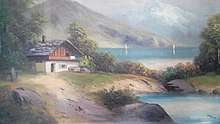
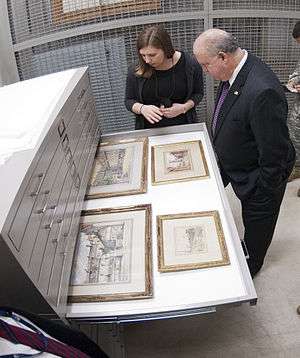
A group of scholars estimate that there are only 300 completed works by Hitler over the span of his life; however, Hitler mentioned in his book, Mein Kampf, that while in Vienna, he produced around two or three paintings a day. Even if he were to paint one portrait a day for the years he spent in Vienna, that number would be well over 600. Peter Jahn, perhaps one of the foremost experts on Hitler's art, said he had two interviews with Hitler. Hitler said in the six years he spent in Vienna and Munich, from 1908 to 1914, he produced over a thousand paintings, a few of them in oils, like Hitler's tree at a track from 1911.
Jahn was one of the original people assigned by Schulte Stratthaus, before Hitler annexed Austria in 1938. Stratthaus had been appointed by Hitler in 1936 to locate and buy paintings Hitler had painted from 1907 to 1912, and 1921 to 1922. Jahn spent nearly four years tracking down Hitler's early works, until he was called into military service.[15] Jahn became the Art Consultant to the German Embassy in Vienna in 1937, where he would then search for, purchase and collect individual pieces of Hitler's art, in order to allegedly destroy a majority of the paintings. Jahn sold one of the largest collections of Hitler's art, about 18 pieces, with an average selling price of $50,000.[15]
One of the most extensive private collections of Hitler's art is housed at The International Museum of World War II in Natick, Massachusetts.[16]
Critical analysis
In 1936, after seeing the paintings Hitler submitted to the Vienna art academy, John Gunther wrote "They are prosaic, utterly devoid of rhythm, color, feeling, or spiritual imagination. They are architect's sketches painful and precise draftsmanship; nothing more. No wonder the Vienna professors told him to go to an architectural school and give up pure art as hopeless".[6]
One modern art critic was asked in 2002 to review some of Hitler's paintings without being told who painted them. He said they were quite good, but that the different style in which he drew human figures represented a profound disinterest in people.[17]
In a report entitled The Water Colours of Hitler: Recovered Art Works Homage to Rodolfo Siviero, prepared by Fratelli Alinari, Sergio Salvi rejects the characterization of Hitler as "a grim Sunday painter" and describes him instead as a "small time professional painter" of "innocuous and trivial urban landscapes".[1]
Paintings
The Courtyard of the Old Residency in Munich (1914) is one of the paintings by Adolf Hitler. He depicts the Alter Hof, a stone quad in front of a large manor.[18] During Hitler's time in Munich, he spent most of his days reading and painting, furthering his dream as an independent artist.[19]
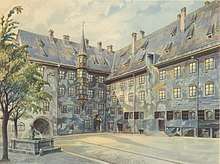
Working primarily in watercolor, Hitler used the medium to express both his love of painting and architecture.[20] The painting shows his style and mastery of watercolor to create strict delineation of the building, but on the left, we see two soft standing trees to contrast the harsh lines of the house. In many of Hitler's watercolors, scholar Charles Snyder notes the detailed attention to humble structures surrounded by water and vegetation, [but] the architecture is of the prime importance. Note plant life, especially leaves on trees. Leaves are typically daubed and dappled in with little regard for accuracy or realism, often used to frame the subject.[21] A small fountain between two trees is painted on the left.
The Courtyard of the Old Residency in Munich and a few other paintings by Hitler are archived in the basement of the Army Center of Military History in Washington, D.C., never shown to the public due to their controversial nature.[22]
Notes
- Enzo Colotti; Riccardo Mariani (30 June 2005). The watercolors of Hitler: recovered art works : homage to Rodolfo Siviero; with texts. Fratelli Alinari spa. p. 5. ISBN 978-88-7292-054-1. Retrieved 4 March 2012.
- Owens Zalamaps, Adolf Hitler, 23.
- Price, Hitler The Unknown Artist.
- Adolf Hitler; Max Domarus (1 April 2007). The essential Hitler: speeches and commentary. Bolchazy-Carducci Publishers. pp. 15–. ISBN 978-0-86516-627-1. Retrieved 4 March 2012.
- Owens Zalampas, Adolf Hitler, 16.
- Gunther, John (1940). Inside Europe. New York: Harper & Brothers. pp. 1–2.
- "Hitler's art". www.sundayobserver.lk. Archived from the original on 2016-03-05. Retrieved 2016-03-02.
- Brigitte Hamann; Hans Mommsen (3 August 2010). Hitler's Vienna: A Portrait of the Tyrant as a Young Man. Tauris Parke Paperbacks. p. 356. ISBN 978-1-84885-277-8. Retrieved 4 March 2012.
- Marc Fisher, "The Art of Evil; Half a century later, the paintings of Adolf Hitler are still a federal case", The Washington Post, Apr. 21, 2002, p. W.26
- Ng, David (30 January 2012). "Would you buy this painting by Adolf Hitler?". Los Angeles Times. Retrieved 13 March 2012.
- "Mullocks auction house claims art by Adolf Hitler sold for $143K". New York Daily News. Associated Press. 24 April 2009. Retrieved 5 February 2015.
- "Hitler paintings sold at British auction house". Deutsche Welle. 24 April 2009. Retrieved 13 March 2012.
- "Hitler painting fetches 32,000 euros in Slovak auction". The Hindu. Agence France-Presse. 30 January 2012. Retrieved 5 February 2015.
- Ziv, Stav (22 November 2014). "Watercolor Painting by Adolf Hitler Sells for $161,000". Newsweek. Retrieved 5 February 2015.
- Snyder, The Real Deal – Adolf Hitler Original Artworks.
- "Natick exhibit: Hitler, 'the failed artist'". Retrieved June 29, 2016.
- Spotts, Frederic Hitler and the Power of Aesthetics (Overlook TP, 2004), ISBN 978-1-58567-507-4, p. 172. See also Adolf Hitler's Paintings
- Price, Billy. Hitler: The Unknown Artist. Houston, Texas: Billy F. price Publishing Co., 1983.
- Owens Zalamaps, Adolf Hitler, 28
- Grosshans, Hitler and the Artists, 33.
- Snyder, The Real Deal: Adolf Hitler Original Artworks.
- Johnson, Benny (20 February 2014). "Inside The Army's Spectacular Hidden Treasure Room". Retrieved 20 July 2015.
The scene above was filmed at the center for the documentary The Rape of Europa.
References
- Barron, Stephanie, Degenerate art: The Fate of the Avant-Garde in Nazi Germany (Los Angeles, Calif.: Los Angeles County Museum of Art, 1991).
- Hitler, Adolf, and Ralph Manheim, Mein Kampf (Boston: Houghton Mifflin Company, 1943).
- Price, Billy, Hitler: The Unknown Artist (Houston, Texas: Billy F. price Publishing Co., 1983).
- Snyder, Charles, The Real Deal - Adolf Hitler Original Artworks, retrieved 10 June 2014.
- Zalampas, Sherree Owens, Adolf Hitler: A Psychological Interpretation of his Views on Architecture, Art, and Music (Bowling Green, Ohio: Bowling Green University Popular Press, 1990). ISBN 978-0879724870
Further reading
- Bennardo, Francesco (2019). Il Diavolo e l'Artista. Le passioni artistiche dei giovani Mussolini, Stalin, Hitler (in Italian). Tralerighe. ISBN 9788832870749.
- Pastore, Stephen R. (2013). The Art of Adolf Hitler: A Study of His Paintings and Drawings. Grand Oak Books.
- Price, Billy F. (1984). Adolf Hitler: The Unknown Artist. Stephen Cook. ISBN 978-0-9612894-0-9.
- Price, Billy F. (1983). Adolf Hitler als Maler und Zeichner: ein Werkkatalog der Ölgemälde, Aquarelle, Zeichnungen und Architekturskizzen. Gallant Verlag. ISBN 978-3-277-00103-1.
- Spotts, Frederic (2004). Hitler and the Power of Aesthetics. The Overlook Press. pp. 123–147. ISBN 1-58567-507-5.
External links
| Wikimedia Commons has media related to Paintings by Adolf Hitler. |
- Hitler's Paintings in German Propaganda Archive
- Hitler's Paintings of Munich sites and today Traces of Evil